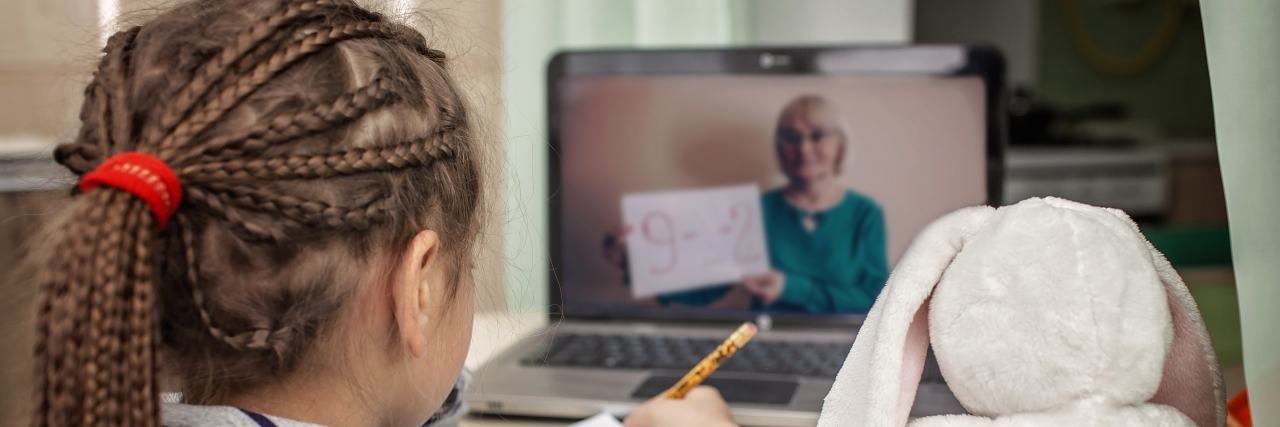Making Online Learning Accessible to Students With Disabilities During COVID-19
Editor's Note
Join The Mighty’s Coronavirus group to connect with other Mighties living through the pandemic. Read the latest updates, share helpful tips, or give and receive virtual support.
Over the last month, schools across the world have moved online to stop the spread of COVID-19. While this has been a huge adjustment for all, it can be particularly difficult for students with disabilities. As a teacher and a person with a disability, I know that online learning is not “one size fits all.” Here are some tips to help you or your child with a disability be able to learn and thrive online!
1. Communicate with teachers.
Teachers are overwhelmed; they have been forced to convert their curriculum to fit an online class, learn various online platforms, and correspond with a lot of anxious parents and students. Additionally, many schools no longer have the support of resource instructors. In all the chaos and without seeing you or your child’s face every day, they may have forgotten all the accommodation details. Write a polite and thorough email to remind teachers of all IEP accommodations, including extra time on tests, alternative formats, or reduced assignments. Be prepared to send a few reminder emails too.
2. Establish a realistic learning strategy.
After clicking through the online class, you might realize that it does not work with your screen-reader or that the assignment count and format will not work well for your child with an intellectual disability or attention deficit disorder. Time to make some swaps! If the site is completely accessible or if, like many college students, you don’t have all the adaptive technology that your school would normally provide, come up with alternate assignments. For instance, instead of completing several daily modules for an English class, ask your teacher if you can listen to a literary audiobook and write an essay about it instead. For students for whom the assignment count is unattainable, consider emailing the teacher to ask which assignments could be cut or asking for double-time to submit them.
3. Create a personal schedule.
We all learn differently and one of the silver linings of online learning is the ability for students to control their day-to-day academic schedule. With the exception of scheduled Zoom lessons, this means that math class doesn’t have to be at 8:00 a.m. If your child loves science, then let that be the first class of the day to motivate them to get out of bed. Try to mix up the subjects so that your child isn’t left doing their least favorite classwork in the evening when energy and focus are dwindling. Alternatively, take medicine into consideration. For individuals with chronic pain or attention deficits, schedule the coursework that requires the most time or focus when meds have kicked in.
4. Take breaks.
Learning a new online platform, tackling a long list of assignments, working around distractions, and not seeing friends and teachers in person can be stressful. Take lots of breaks. This sudden change is hard on everyone, especially individuals with anxiety disorders. Go outside, walk the dog, dance, play a sport — just get some fresh air and movement. It can boost your mood, help you focus on work later in the day, and you can consider it P.E.
5. Use outside sources.
Let’s face it — most online textbooks aren’t exactly riveting. Luckily, the web is your oyster. When your child can’t focus on the chapter about plate tectonics, find a documentary on YouTube or another streaming service. The graphics and dramatic voice of the narrator make the subject much more interesting. In my classes, I always tell my students they can find an audiobook version of the assigned reading on YouTube to help them retain the plot. Khan Academy offers lots of tutorials and is also an excellent resource that allows students to learn at their own pace.
6. Pursue a passion project.
While we teachers miss interacting with our students and being right there to help them learn, many educators appreciate the autonomy online learning gives students. Instead of having a fixed schedule of classes and a set class period in which to finish an assignment, students can now arrange their own schedule and work at their own pace.
Let’s take this one step further. In the time between classwork or if you are completely homeschooling, let the child decide what they learn. Have a son who is obsessed with Minecraft? Have him read about and collect rocks and minerals. Your daughter won’t stop singing “Frozen” songs? Have her research Norway. Students are far more engaged when they have a hand in picking the lesson. This is certainly something that needs to come back with us when we re-enter the classroom.
Distance learning has been a huge change, and for the disability community, it means having to come up with even more workarounds. Someday we will return to normal face-to-face lessons and teachers will review all the material taught online. But at this time, individuals with disabilities need to make the curriculum fit their needs and with the support of teachers and families, we can all keep calm and keep learning!
For more on parenting during quarantine, check out the following stories from our parenting community:
Getty image by Maria Symchych-Navrotska.

